Suicidal Urbanism: The City as IED

[Image: The World Trade Center 7 collapsed on September 11, 2001.]
An Oxford study came out recently suggesting there are particular psychological factors that make up a ‘universal mindset of engineers,’ which may make them more predisposed towards terrorism when aligned with certain negative social conditions found, for instance, under repressive governments in parts of the Muslim World. There’s been quite a bit of research in the past showing that many terrorists and members of radical movements have been highly educated, but little investigation apparently has been made into their given background and academic discipline. Surprisingly, this study indicates a large portion of identified radicals have had engineering backgrounds.
The research looked at 404 individuals of 30 nationalities who had participated in radical Islamic groups from the 1970s to the present. Of that group, 196 had pursued higher education, and the researchers were able to identify the academic fields of 178. Those with engineering backgrounds constituted 44 percent of the group. (See "Study traces tech link to radical '70s groups")
I’m not sure how reliable this study—entitled ‘Engineers of Jihad’—actually is, but personally I don’t find a link between would-be terrorists and engineering extraordinarily surprising. It may sound utterly basic, but plotting takes scheming, planning, critical structural and systems analysis, especially considering the high degree of challenge terrorists face with this new techno-militaristic state of global Empire, of which the counter-imperial responses have proven both ingeniously primitive and sophisticated. In some ways I think it makes perfect sense, that someone—or, a group of someones—who would be interested in pulling off the sort of dramatic political urban disruptions that seem to define modern terrorism today would be naturally inclined towards the challenge and solution based logistics of engineering. After all, subversion is a craft, a science, and it most definitely requires a design.
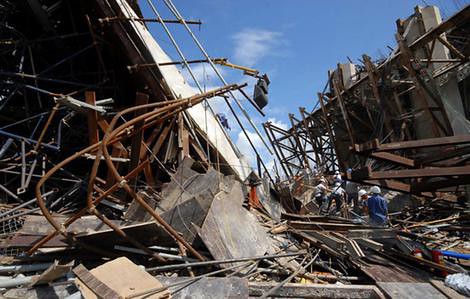
[Image: A Japanese-funded bridge under construction in southern Vietnam collapsed September 26, 2007 killing 60.]
However, the study is not an examination of engineers in and of themselves, but uses its research into the ‘engineer’s mindset’ as a prism to try and better understand Islamic political violence, which is certainly a fascinating topic. And, again, which makes sense to me if we think of both globalization and even the stifling conditions under extremist regimes as spatial systems of leviathan government control (both in the form of democracy and dictatorship), each functions as a kind of systemic architecture with impenetrable bureaucracy that functions as a matrix of exclusion in its own right. If you think of government in terms of a kind of abstract superstructure, it doesn’t seem farfetched then to me that the logical counter to the urban expansion of Empire (or dictatorship, for that matter) would seem to be something requiring at the very least engineering, of all types—this is, if we accept the western city as the monolithic piston of a global capitalist machine, the fundamentalist state as the bastion of its opposite, and the urban environment as the medium of contemporary conflict where the forces of neoliberal hegemony and fundamentalist anti-capitalism collide. In this light the 'terrorist engineering' is a form of anti-western undoing, or neoliberal de-engineering, perhaps.
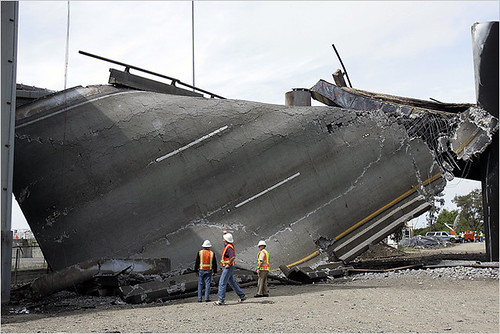
<[Image: SF Freeway Collapses, Leading Some to Question Steel's Integrity, April 30, 200, Wired.]
The researchers Diego Gambetta and Steffen Hertog of Oxford’s Department of Sociology look at the psychology of the engineer as being partially defined by overtures of ‘monoism’ and ‘simplism’ and the notion that engineers are driven to develop the best, or often the ‘right’ solution, as well as promulgating rationality as a means to interface with and streamline large scale societal solutions. Furthermore, they conclude, citing prior research from the U.K., U.S. and Canada, that engineers are stereotypically also inclined towards the conservative side of the political spectrum as well as having a religious affiliation. All of which, they conclude makes for a volatile concoction of psychological and socioeconomic elements that could theoretically, in an environment that limits opportunity and generates a sense of injustice, lead to a sort of terrorist engineering syndrome, or a pathological deconstructivist complex bent on rules, organization, and grandiose reconstitution lured by the tendency of radicalism.
Though, I, and am sure many others, too, would argue that the qualitative assertion of the Muslim World being more depriving of opportunity than the Western World would need to be much more examined. Certainly, most would agree that the Western world provides far more opportunity in general, but how exactly should we measure the sense of injustice and frustration that stems from that? Are Americans any less frustrated by their own society? Without stooping to the obvious answer, I ask, how do we need to compare the relativism of that? Are the likely provocative scenarios to rendering Jihadi engineers really indigenous to the Muslim world? I don’t think the research gets at the acute relationship between Arab society and the plight of the engineer there, or maybe it does, I must admit I have not read the entire paper. But, in order to turn Arab engineers into would-be terrorists I would think tons of data would need to be collected not only on the qualitative mindset variables of engineers but on the symptomatic social conditions in order to explain this phenomenon in comparison to other cultures. Further, I wonder then if the researchers conclude that terrorism is then merely some displacement of Muslim rage against their own system. And, how do we even define terrorism in this case, given that the west has its own brand of fundamentalism, its own brand of inner political violence, its own internal terrorism. Not to mention its own military backed brand of foreign terrorism. How then might we diagnose American engineers? Are they too inclined towards some sort of radicalism?
Researchers don't know exactly how the various elements--the mindset, expectations and experience--combined to produce the radicalization of engineers … Being an engineer isn't the cause of anything, he said. And if you know that someone is an engineer, it doesn't tell you anything about his or her political preferences and personality, he added.
But, it is of course curious to think about a set of identifiable personality traits that not only jive with terrorism but specifically translates in the form of an engineer’s mindset. I don’t know, the research could be brilliantly onto something, or may be desperately reaching.
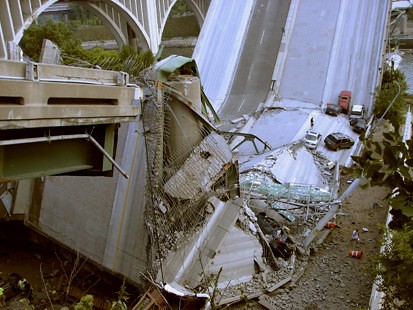
Either way, should there actually exist a direct engineering/terrorist correlation, from our whacked perspective the prospect is pretty fascinating. If this could be gauged somehow during the epistemological development of a person’s childhood, what would the profile of an immature pre-terrorist look like, what thought patterns would emerge, characteristically, how would that identity be expressed—through what behaviors, specifically in relation to an engineering motive? What would mark their knowledge interests? How would this mindset be engineered? Would these epistemological leanings be more dualist in nature, or relativist? Hell, what kinds of toys would these little prodigious harbingers of destruction play with, what meanings could we read into the heaps and mounds they’d fancy in the sandbox? What would their earliest terrorizations serve up in the classroom, in what forms? What patterns would mark their relation to authority, to the built world, and when would this cultural frustration that Hertog speaks of first take hold in their lives? Through what youthful manifestations or imaginations might this ‘mindset’ come to reveal itself, to enact itself on the world? Would brand new teams of developmental psychologists inscrutably screen children for their terrorist potential based on their love of Legos? I guess I am as interested in any intrinsic engineer/terrorist connection as I am in the cultural explanations, which is what the study is trying to do, I think—saying, in effect: take this mindset in these cultural conditions and increase the propensity for terrorism.
I wonder though would some universities quickly become intensely skeptical of any inclination towards engineering if such an association with a terrorist propensity were proven, while other universities might become increasingly fostering of the discipline? What if the world became divided into warring armies of pro and anti terrorist engineers? To a degree that it is not already, of course.

What if one day we come to find out that a sprawling metropolis had been mysteriously designed to more or less terrorize its population, where architects were used as proxies for rogue engineers and their secret marvels of sudden civil collapse? And we find that terrorists have become land-developing moguls quietly expanding their portfolios to new hot spots abroad, investing billions in this future city only with the intention of eventually setting it ablaze at the most opportune moment. Our researchers here might call them Jihadi Cities.
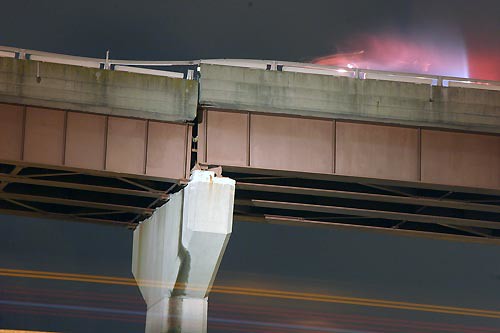
[Image: Partial collapse in Albany NY, 29 Jul 05 13.]
Promising new lifestyles for the global urbane this city attracts westerners from all over with exotic flourishes of foreignality, and innovative projects in urban design that guides people through refreshing arteries of transit into magnificent public spaces that seem to hint at some kind of revolution in the next iteration of the global city. The street culture and urban experience are so attractive people spend a majority of their days outdoors basking in the presence of a bubbling publicity, the constant ooze of festivity. Then, when the fervor of commerce and showy neoliberal fanfare reaches an afternoon peak, just like that, the metropolis suddenly blooms into a masterful display of chaos and disaster, as it has been designed to tear itself apart from the inside, cave-in in a matter of minutes like a great urban crater. Megastructures meticulously tumble to the ground with geomechanic landslide-like wizardry, timed impeccably with the instant fall of dozens of other buildings through out the city’s inner core that fulfill their destinies in splendid calculations of self-dismantling sidewalk tragedy. Volumes of architectural mass merely wait for their cues to spill into a plume of concrete dust at any second. Then a network of hillside towers, stilted highway structures, breathtaking sky bridges, subterranean traffic tubes, sewage tunnels, and the loftiest architecture in between collapse in a spectacularly synchronized flattening of the built world, as the entire city comes to reveal itself as some mega contraption for carrying out the grand plot of someone's terrorism, as the new colossal IED (improvised explosive device) of the future world.

[Image: Minnesota bridge collapse, Aug, 2007.]
Could you imagine how insane that would be?
If 9/11 dawned a new age of architectural terrorism—not just architecture made into a weapon, but architecture designed as a weapon—might we one day see a whole sinister machine city function as a kind of regional IED? I mean, I know this is obscenely ridiculous to ponder for even a second half-seriously, it would take the terrorist engineers decades of unfathomable secrecy and butt loads of cash and builders to erect and develop such an IED City, but what if cities became large scale architectural traps in the future, massive ploys for terrorism? What if we ended up unknowingly living in some futuristic Dummy City? What if cities could be entirely faked for the purposes of espionage and terrorism? What if the future of urban development fell under the rubric of some sort of War On Terror tactic where both sides began to establish entire decoy downtown districts for the purposes of attracting each other’s legions into a certain geography to mark their own death? It’s certainly something for a bad Sci-Fi flick, but consider it akin to an earthquake prompted by the push of a button, setting off an abominable domino effect of architectural crumbling and wilting and widespread panic. Only Tom Cruise could survive such an absurd thing, and perhaps Will Smith.
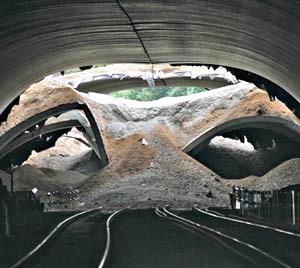
[Image: THE damage caused by the collapse of a Tesco development on to a commuter rail line was revealed yesterday. The picture shows the view from inside a tunnel that caved in over one of the main lines between London and Birmingham, at Gerrards Cross in Buckinghamshire. August, 2005.]
What about the CIA, who would surely find such a tactic equally appealing, to erect some kind of quasi city, say, in Sudan, under the pretenses of foreign investment and international diplomacy, completely catering to an urban planning of Islamic radicalism, only to scoop up "jihadi suspects" in some kind of city-sized net. So that Mosques could function like massive Venus flytraps, while newly funded souqs became the unassuming detention facilities for a whole new range of terrorist suspects. Terrorist round-ups would somehow manage themselves under the disguise of an enclosed central bazaar.
If architecture has always possessed the capacity to terrorize, then what would that look like by the end of the 21st century?
Or, perhaps these rogue engineers would decide to take a far less overt tactic. What if the next great starchitect turned out to be a political conspirator who secretly programmed the building with subtle nuances of architectural trauma? For instance, using the building’s design to grossly influence the occupant’s pathology, so the engineer becomes a kind of stealthy psycho-spatial terrorist behind the scenes, a radical builder, a mindbender—architecture and engineering as a subversive act—subjecting his victims to a more or less silent warfare through the softer phenomenology of the architectural experience? What if these future terrorist engineers were heavily versed in the science of spatial cognition, fully aware of how geometries, curves, light and spatial perception could influence a person’s mood, tweak their cognitive structures, and ultimately harness a person's destructive behavior? Using architecture to program Jihad. He would be a sort of neo-Freudian masterbuilder; part Da Vinci, John O’keefe, Cecil Balmond, Lynn Nadel, Bin Laden all fused into a reinvented Karl Stromberg kind of Bond villain. He would be a genius in the art of designing cities for the purposes of their inimitable seduction and collapse. He would be a mythic sorcerer of urban decay, and heading deeper and deeper into an age of hyper-urbanization people would fear natural disasters only half as much as they would his brutal and stylish suicidal urbanism.







4 Comments:
"Promising new lifestyles for the global urbane this city attracts westerners from all over with exotic flourishes of foreignality, and innovative projects in urban design that guides people through refreshing arteries of transit into magnificent public spaces that seem to hint at some kind of revolution in the next iteration of the global city"
Does this remind anyone else of Dubai (or Beijing or, to a lesser extent, LA's recent attempts at a new "urban renaissance)?
One could easily make the argument that the "engineers mindset" has already given us cities that are IED. Take the above example of LA. The city is completely dependent on oil, water, food and other manufactured goods from outside, not only for first world style survival, but for surival in general. Plus there is a transportation system that both threatens to completely breakdown without access to individual automobiles and also operates in many ways as a defacto border system creating segreation between various communities. The list could go on. Arguably these are not intentional acts (at least not on a individual or consious level) but they none the less would seem to rig the city in such a way that a breakdown in one part of the system would set off breakdowns in the rest like the preverbial powder cage.
Not to pick on LA.. most cities would appear to be more or less dependent on an increasingly precarious network of fragile systems (ecological, economical, social) to maintain their civilization, so to speak.
yes, absolutely, i agree, to some degree the city as a format for an IED is already in place without the intentional design of any terrorists.
certainly, thanks for reminding me of this critical layer.
great post, I wrote something similar awhile back http://soobdujour.blogspot.com/2007/11/engineers-of-jihad.html
good weblog...hope be successful always.
Post a Comment
<< Home